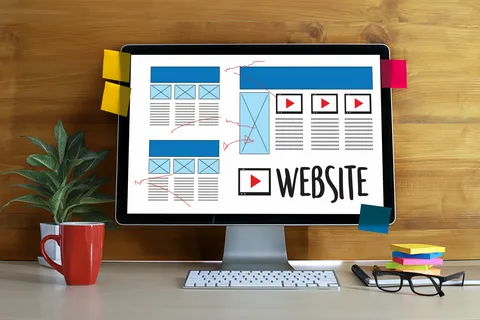In today’s digital world, a strong online presence is vital. The need for Website Design & Development that is both responsive and user-friendly is no longer optional—it’s essential. Many businesses underestimate how crucial a seamless experience is across devices. From smartphones and tablets to desktops, users expect fast-loading pages with intuitive navigation and visually engaging layouts. That’s why embracing responsive web development with a thoughtful UX/UI strategy is a game changer for any brand looking to make its mark online.
Responsive web development ensures that your site adapts fluidly to various screen sizes while maintaining optimal performance. UX/UI strategy goes hand in hand by prioritizing a user-centric design that focuses on clarity, consistency, and engagement. Combining these approaches creates a web experience that delights visitors and can significantly impact your conversion rates. In this article, we’ll explore how responsive web development and UX/UI strategy boost your site’s usability, speed, and aesthetic appeal while integrating Website Design & Development best practices.

Understanding the Role of Responsive Design
Responsive web development means crafting code and layouts that respond to the user’s device. Rather than designing separate sites for mobile and desktop, a responsive design uses a flexible grid system and media queries. When paired with a UX/UI strategy, this approach ensures that layouts don’t just look good—they feel intuitive. Here, the focus is on presenting content effectively, no matter the screen resolution. Implementing responsive design isn’t just a technical decision; it’s a strategic one that aligns with best practices in Website Design & Development.
Responsive sites help reduce bounce rates. Users who land on your homepage from a mobile search expect clickable links, readable text, and images optimized for smaller screens. Performance becomes critical—slow load times lead to frustration and abandonment. Responsive web development addresses these issues while UX/UI strategy ensures that call-to-action buttons are placed where a thumb naturally rests, that font sizes remain legible, and that color contrast enhances readability.
Enhancing Usability through UX/UI Strategy
A strong UX/UI strategy places the user at the heart of every design decision. UX (user experience) focuses on the journey a visitor takes—from landing on your homepage to completing a goal such as signing up or making a purchase. UI (user interface) deals with how the site presents itself visually. When you integrate both within responsive web development, you create an environment that is not only adaptable but also enjoyable to navigate.
Effective UX design identifies what visitors need and simplifies interaction. Menus adapt based on device size; images resize gracefully without pixelation; content loads progressively to maintain speed. A well-designed UI enhances visual hierarchy, guiding the visitor’s eye to critical elements such as forms, buttons, or featured content. When deployed thoughtfully within your Website Design & Development plan, this strategy ensures that both function and aesthetics work in harmony to engage your audience.
Technical Considerations in Responsive Development
Responsive web development isn’t just about appearance; it’s also about performance. From optimizing images and compressing assets to minifying CSS and JavaScript, technical fine-tuning ensures fast-loading pages across devices. For search engines and users alike, speed matters. Google’s mobile-first indexing prioritizes websites that perform well on mobile devices, making responsive sites with strong UX/UI essential for modern SEO.
Another important aspect is accessibility. Alt tags, semantic HTML, and keyboard navigation help ensure that your site is usable by people with disabilities. Not only is this ethically important, but it also aligns with wider standards of professionalism in Website Design & Development. Accessibility enhances usability for all users, and search engines reward inclusive practices with better visibility.
Crafting Content That Complements UX/UI
Content and design go hand in hand. Responsive web development and UX/UI strategy flourish when paired with clear, engaging content. Headings, paragraphs, and calls to action must scale and position correctly on any device. Typography should be legible on small screens while keeping the overall visual tone consistent. Content hierarchy helps guide the user through your messaging effectively.
While designing, consider how copy blocks align with images or interactive elements like sliders or video embeds. A well-placed paragraph can lead a user’s eye to a CTA button. With smart spacing, whitespace, and alignment, content feels breathable and persuasive. This careful attention is a hallmark of expert Website Design & Development projects that aim for both usability and conversions.
Case Study: Building a Better Brand Experience
Let’s say a medium‑sized business partners with a leading agency for a website overhaul. The goal: enhance user retention, reduce bounce rate, and improve mobile conversions. The agency undertakes full responsive web development with a comprehensive UX/UI strategy. Mobile and desktop layouts are developed in parallel; wireframes evolve into interactive prototypes, and user testing provides valuable feedback.
The final build delivers a website that adapts flawlessly across devices. Buttons remain thumb‑friendly on mobile, forms are simple and intuitive, imagery loads only when needed, and CTAs are prominent yet unobtrusive. The client updates the live site using content from their existing blog and product pages, with no sacrifice in visual appeal or usability. Performance metrics show reduced page load times and increased engagement. All of this reflects the power of marrying responsive web development with UX/UI strategy under the banner of Website Design & Development.
Integrating Your Website into a Stronger Digital Strategy
Your website doesn’t exist in isolation. Tools like analytics platforms and content management systems benefit from the same responsive and UX-centric design principles. You might host your site at a domain—such as https://wajisolutions.com/—with clear calls to action, streamlined navigation, and consistent branding. Whether users arrive via search engines, social campaigns, or referrals, their journey reflects the quality of your Website Design & Development process.
The first impression matters. A visually appealing, fast-loading site with intuitive navigation builds trust. The second impression does too. Visitors who stay are more likely to convert. Platforms like https://wajisolutions.com/ illustrate how professional design and development, underpinned by responsive layouts and strong UX/UI, can elevate conversion rates and brand perception.

FAQ
Why is responsive design so important for modern websites?
Responsive design ensures your site looks and functions well across all devices. It reduces bounce rates, improves user experience, and is favored by search engines. Incorporating UX/UI strategy enhances navigation and visual appeal within that framework.
How does UX/UI strategy improve conversion rates?
By placing user needs at the center, UX ensures seamless navigation while UI focuses on aesthetics and usability. Together, they guide visitors efficiently toward calls to action, increasing engagement and conversions.
How often should I review my responsive design and UX/UI elements?
Regular reviews—especially after major content updates or design refreshes—help maintain performance and usability. Analytics tools can reveal drop-off points, helping you refine the user journey with further UX/UI adjustments.
How can I measure the success of responsive web development efforts?
Use metrics like page load times, bounce rate, session duration, and conversion rate across device types. A decrease in bounce rate combined with improved mobile engagement indicates successful responsive development paired with effective UX/UI design.
Is accessibility part of responsive web development and UX/UI strategy?
Absolutely. Accessibility—such as keyboard navigation, alt text, and readable font sizes—ensures all users can interact with your site. It enhances usability and reflects best practices in Website Design & Development.
Conclusion
In summary, responsive web development combined with a user-centered UX/UI strategy is not just ideal—it’s essential in today’s competitive online environment. By ensuring your website scales across devices, loads quickly, and offers intuitive navigation, you enhance user engagement and drive conversions. Whether you manage your online presence through a platform like https://wajisolutions.com/ or another site, integrating these strategies will set your brand apart. Ultimately, thoughtful Website Design & Development, grounded in responsive frameworks and purposeful UX/UI design, delivers results that last.
Ask ChatGPT





